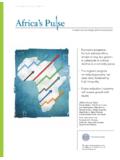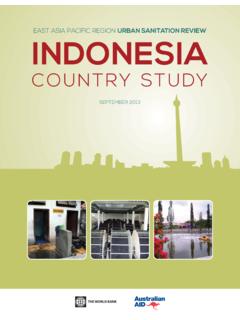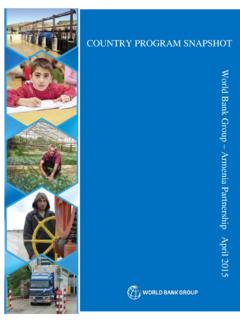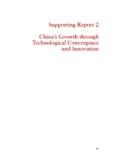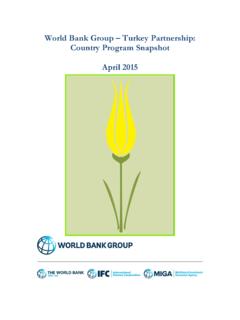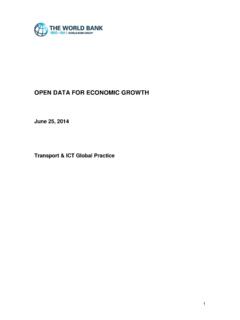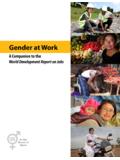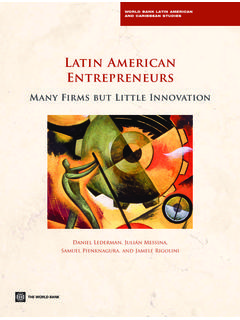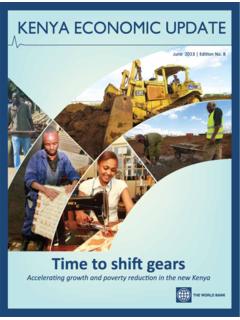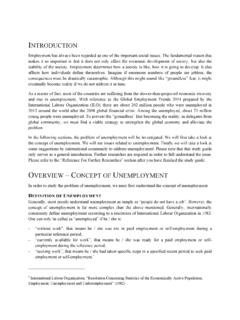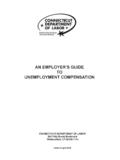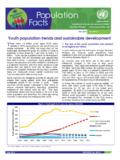Transcription of ChAPTER 3 Youth Inactivity and Unemployment - …
1 23 ChAPTER 3 Youth Inactivity and Unemployment 24 | BREAkINg ThE BARRIERS TO Youth INClUSION3 .1 Youth Inactivity ; Young People Who Are Not in Education, Employment, or Training; and Unemployment An Overview Youth Inactivity is a massive problem in Tunisia . Young people who are not in education, employment, or train-ing (NEETs) comprise a substantial proportion of the potential Youth labor force in Tunisia (see figure and box ). Young people without work who are no longer attending any school or training program spend on aver-age more than three years searching before finding a job.
2 Tunisia s Youth are not only struggling economically; they are marginalized and economically excluded. Many unemployed young women and men see little chance of ever finding work and starting their careers. Formal em-ployment grows ever more distant for the long-term job-less without connections; few young Tunisians are able to find employment. This ChAPTER presents the key chal-lenges related to Unemployment and Inactivity . The chap-ter presents Youth labor exclusion in decreasing order of exclusion and starts with Youth Inactivity (NEETs) and Unemployment , while the subsequent ChAPTER proceeds to highlight the underemployed and informally employed, and ends with Youth who are formally in three young men in rural Tunisia (33.)
3 4 per-cent) and one in five in urban Tunisia are NEET . Rates are even higher for young women. One out of every two For us, Unemployment is a kind of blasphemy; an unemployed is not a person, society itself does not accept him, he is not part of the circle of society. That is the true meaning of unemployed : a person who is not active in the heart of the society. Tell me, what use is that person? Unemployed graduate, Sidi Bouzid1 . labor Force Status2 . Time Use3 . Employment Status4 . Work Status5 . FormalityIn Labor ForceFull-time workerWage employedEmployedFormalInformalSelf-emplo yedUnpaid or family workerPart-time workerVoluntary part-time employedInvoluntary underemployedJob seekerUnemployedNEETOut of Labor ForceInactivity or houseworkDiscouragedInactiveIn education or trainingStudentStudentFigure 3.
4 1 . Youth Employment and NEET FrameworkSource: Adapted from AfDB Inactivity and Unemployment | 2524 | BREAkINg ThE BARRIERS TO Youth INClUSION young women in rural Tunisia ( percent) is NEET; about one in three urban areas ( percent) (see figure ). The economic loss caused by this lack of productive activity is enormous. Equally important, however, is the social exclusion that millions of young Tunisians experi-ence as they are forced to squander their skills, creativity, and large number of young Tunisians are leaving the countryside and often migrating to desolate urban areas.
5 The proportion of NEET in urban Tunisia are less se-vere than in rural areas. However, in urban areas, the primary destination for many young job seekers more than one-fifth of young men ( percent) and about one-third of young women ( percent) is NEET (see figure ).The severity and regional incidence of NEET reflect the extent of despair among Youth , which is particu-larly acute in the interior and south, the cradle of the 2011 revolution . NEET affects more than one-quarter in the coastal region ( percent urban, percent rural), more than one-third in the south ( percent urban, percent rural), and about one-third of Youth in the interior region ( percent urban, percent rural, see annex 3, figure ).
6 These young people, ex-cluded from the labor market for years, are referred to as Box 3 .1 . Young People Who Are Not in Education, Employment, or Training A Joint Indicator for Youth Unemployment and InactivityThe acronym NEET refers to young people who are not in education, employment, or training . NEET is comprised of all Youth who are either unemployed or inactive. By going beyond the arguably narrow lens of Unemployment , the NEET concept helps policy makers consider the needs of all young people who have fin-ished education and training and should be working.
7 The NEET indicator is a powerful tool to analyze Youth exclusion by focusing on all young people experiencing difficulties in transitioning from education to work is important because it more comprehensively defines Youth Inactivity , which standard Unemployment statistics generally overlook . Inactive Youth are those young men and women already discouraged from looking for work despite their young ages. Instead of neglecting these young people, the NEET indicator encourages policy makers to consider that discouraged young people require at least as much government support as the un-employed.
8 Discouraged Youth often referred to as inactive Youth are particularly vulnerable. Inactive Youth are the litmus test for the effectiveness of Youth policies aimed at fostering social is a well-established concept . Many member countries of the Organisation for Economic Cooperation and Development (OECD) and a growing number of developing countries are using the NEET indicator to com-plement Youth Unemployment statistics. It is systematically measured by the International Labor Organization and presented in its annual flagship report, Global Employment Trends for Youth (ILO 2013).
9 The OECD is also reporting NEET shares, and the organization has prominently applied the indicator in its recent African Economic Outlook 2012, which focused on promoting Youth employment in Northern and Sub-Saharan Africa, including Tunisia (AfDB 2012a), and in the World Economic Forum s Global Youth Unemployment Study (WEF 2013). Recently, NEET was proposed by the United Nations High Level Panel to be used for the Post-2015 Development Goals (United Nations 2013). Originally coined by the government of the United Kingdom, the acronym NEET is used officially by statistical agencies in Canada, Ireland, Japan, Mexico, Spain, and South Korea.
10 While more efforts are needed to measure NEET globally, most labor force surveys already include the required variables to establish reliable NEET : World Bank | BREAkINg ThE BARRIERS TO Youth INClUSION Generation Jobless (Economist 2013). Youth in the in-terior face an especially unproductive abyss of years tran-sitioning between their school and work lives. As focus groups revealed, Youth have little faith in their skills or qualifications as they attempt to navigate a system they perceive to be rife with corruption. The interior region is 3 .2 . Youth NEET in Rural Versus Urban AreasSource: World Bank 2012d; : Figure includes all Youth aged 15 3.

